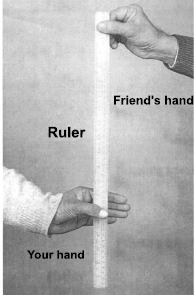Which of the following does not represent the equation of motion for constant acceleration?
| 1. | \(v=v_0+at\) | 2. | \(v^2=v_0^2+2a(x-x_0)\) |
| 3. | \(x = x_0v_0+\dfrac{1}{2}at^2\) | 4. | \(x = x_0+v_0t+\dfrac{1}{2}at^2\) |
Prefer Books for Question Practice? Get NEETprep's Unique MCQ Books with Online Audio/Video/Text Solutions via Telegram Bot
NEET MCQ Books for XIth & XIIth Physics, Chemistry & Biology(Take \(g=10\) m/s2)
| 1. | \(30\) m | 2. | \(25\) m |
| 3. | \(45\) m | 4. | \(20\) m |
Prefer Books for Question Practice? Get NEETprep's Unique MCQ Books with Online Audio/Video/Text Solutions via Telegram Bot
NEET MCQ Books for XIth & XIIth Physics, Chemistry & BiologyA ball is thrown vertically upwards with a velocity of \(20\) m/s from the top of a multistorey building. The height of the point from where the ball is thrown is \(25.0\) m from the ground. How long will it be before the ball hits the ground?
(Take \(g=10\) ms–2.)
1. \(3\) s
2. \(2\) s
3. \(5\) s
4. \(20\) s
Prefer Books for Question Practice? Get NEETprep's Unique MCQ Books with Online Audio/Video/Text Solutions via Telegram Bot
NEET MCQ Books for XIth & XIIth Physics, Chemistry & BiologyYou can measure your reaction time by a simple experiment. Take a ruler and ask your friend to drop it vertically through the gap between your thumb and forefinger (figure shown below). After you catch it if the distance d travelled by the ruler is \(21.0\) cm, your reaction time is:

| 1. | \(0.2\) s | 2. | \(0.4\) s |
| 3. | \(0\) | 4. | \(0.1\) s |
Prefer Books for Question Practice? Get NEETprep's Unique MCQ Books with Online Audio/Video/Text Solutions via Telegram Bot
NEET MCQ Books for XIth & XIIth Physics, Chemistry & BiologyGalileo’s law of odd numbers: The distances traversed, during equal intervals of time, by a body falling from rest, stand to one another in the ratio:
| 1. | as the odd numbers beginning with unity. |
| 2. | as the even numbers beginning with unity. |
| 3. | as the square of odd numbers beginning with unity. |
| 4. | as the square of even numbers beginning with unity. |
Prefer Books for Question Practice? Get NEETprep's Unique MCQ Books with Online Audio/Video/Text Solutions via Telegram Bot
NEET MCQ Books for XIth & XIIth Physics, Chemistry & Biology